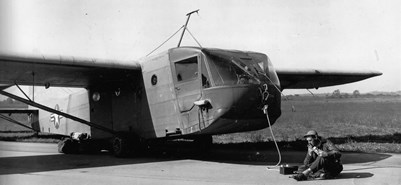|
|

T/Sgt George V. Blevins, Communication Chief, Headquarters, 316th Troop Carrier Group, checks an inter-communication phone set of a glider, prior to taking off from Smyrna Army Airbase, Tenn., to Camp Campbell, Ky., during the Exercise. Sgt Blevins is a resident of North Wilkesboro, N.C. 1948.
---Army Signal Corps, National Archives

This glider appears to have a D-1 Auto pilot installed |
The first TC Group to get the new CG-15A in the European Theater was the 440th Troop Carrier Group. There were some in the Philippines. None were used in combat.
In comparison to the CG-4A the CG-15A:
- Increased tow speed to match the C-47 cruising speed of 180 mph
- More aerodynamic with the crash protection designed into the nose of the glider
- Crash protection for the load
- Tow release was centered below the windshield rather than above the windshield
- Better overall cockpit visibility
- Increased load of 500 lbs more than the CG-4A
- Emergency doors were placed on both sides of the cockpit.
- Shorter wingspan, reduced over 21 feet to 62 feet 2 ½ inches
- Oleo struts replaced CG-4A wheel struts that tended to rupture on very hard landing
- Pilot's seat position were vertically adjustable
- Troop seats were 3-man, canvas/steel tube, upward folding, rather than the wood box
- Slotted flaps were added for better control
- Full width loading ramp hinged to floor providing skid protection for cockpit
The first of seven CG-15A gliders that were sent to the UK in late spring of 1945 were assigned to the 440th
Troop Carrier Group. None of the CG-15A gliders in the European Theater were used in combat. Only one other
American glider was used in combat and that was the CG-13A but that is another story. --Charles Day
Keith Smith in letter to Jan Bos (Netherlands):
I flew the CG-15A, which was a later version of the CG-4A. It had numerous improvements, but I don't think that it had ever been used in combat.
Instead of spoilers, it had electrical wing flaps. This necessitated a wind driven generator and a battery. This gave us cockpit lighting, as well.
The wingspan was 20 feet shorter, but the payload was still about 4,000 lbs., making the wing loading a bit greater and with a higher sink rate.
The nose was improved along the lines of the Griswold modification made to the CG-4A. The towline attach point was in the center of the nose and an instrument flight
capability was included which resulted from installing a device attached to the tow line in front of the nose and an instrument to give the pilot an idea of how to maintain position,
under instrument conditions, on the tow plane. Plus, there was a venturi driven turn and bank instrument for use after cutting loose from the tow.
The landing gear was modified to some extent and the "runners" or whatever they were called on the CG-4A under the forward part of the fuselage were removed. The cockpit had doors on both sides for the
pilot's and copilot's use. Other than these changes the two gliders were quite similar, I believe.
In the 18 months that I flew the CG-15A, I logged about 105 hours and lots of landings. After checking out in the glider at the school set up in Greenville, SC, I was assigned to the school as
instructor. Our missions were mostly training with the Airborne Troops at Fort Benning and Fort Bragg and occasionally putting on "firepower demonstrations" at Eglin AFB in Florida. I
participated in demonstrations and maneuvers which employed up to maybe 20-30 gliders, but nothing like the huge formations of WWII.
|
|
|
GLIDERS
CG-4A
CG-15A
CG-15A Testing C Day excerpt
Funds for X gliders 1941-45
HORSA
STORIES and REPORTS
TOW SHIPS
TOW KNOW HOW
|











